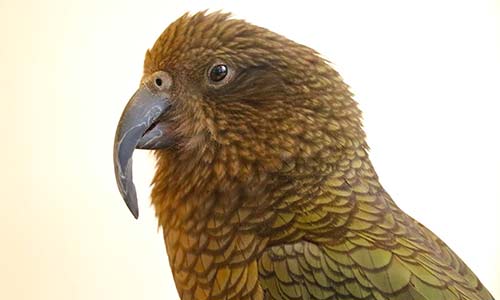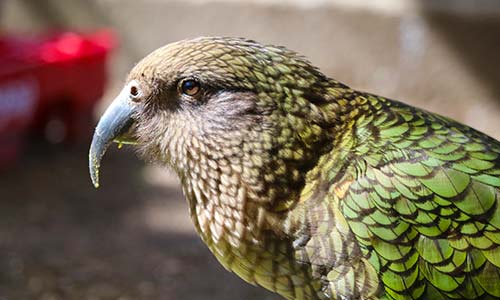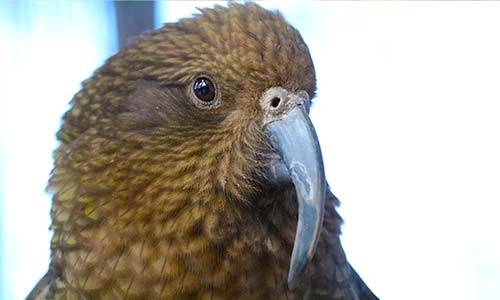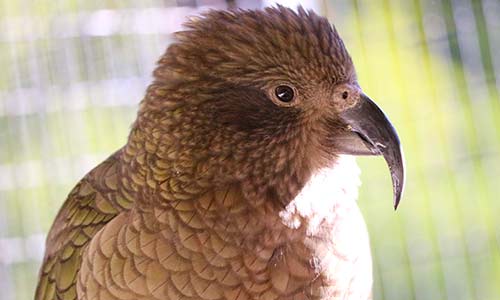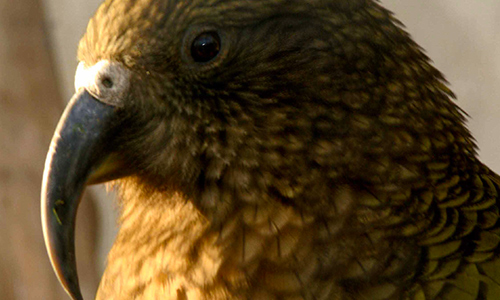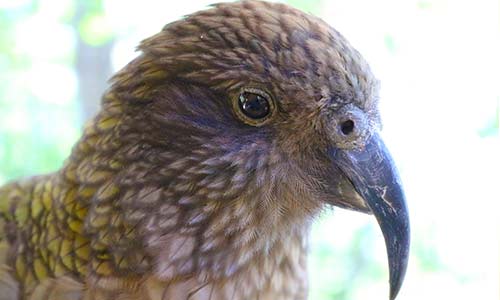Kea
Nestor notabilis
About the Kea

Geographic Range:
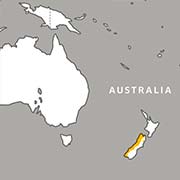
Class: Aves
Order: Psittaciformes
Family: Psittacidae
Genus: Nestor
Species: notabilis
The kea is the world's only alpine parrot, and it gets its name from the call it makes while flying: "kee-aa." Unlike most birds, male and female keas have identical plumage—olive green, scarlet and brilliant orange underwings. Known for their curiosity and cleverness, keas have been known to investigate hikers’ backpacks, boots and cars!
Kea Facts
Appearance:
Unlike most birds, male and female keas have identical plumage—olive green, scarlet and brilliant orange underwings. Their grey-brown upper beak is large, narrow and curved. The kea’s strong beak makes it a good climber. Two of the kea's toes face forward, while two face backward, enabling the bird to grip branches securely and hold food while eating. The kea's natural curiosity helps it adapt to new environments.
Size:
Weight: 1.5 to 2.2 pounds; males are up to 20 percent larger than females
Length: 1.5 feet
Diet:
In the wild, keas eat insects, other birds, small mammals, carrion, fruit, leaves and flowers. They're also known to forage from human garbage.
Reproduction:
This bird reaches maturity at 3 years of age. It may be polygamous; one male may mate with multiple females. The kea’s breeding season begins in mid-winter and may extend to late spring or early summer. Eggs are laid from January to July and have a 21-day incubation period. Typically, there are two to four eggs per clutch. The bird builds its nest on the ground under trees, in rock crevices and burrows between roots, which makes them particularly vulnerable to predation by cats, ferrets and opossums. Scientists have found access tunnels from 3 to 20 feet in length, leading to a large nesting chamber containing lichen, moss, ferns and rotted wood.
Gestation:
The female incubates the eggs for 25 days and rarely leaves the nest during this time. The male will feed her throughout the incubation period. When the chicks hatch they are blind and helpless. For the first month the male will continue to feed the female, who then feeds the chicks. After that month, the male kea will feed both the chicks and the female. Chicks fledge when they are between 9 and 13 weeks old and will rely on their father to feed them for another 5-6 weeks. Adults are very patient with juveniles and will often allow them to eat first.
Habitat/Range:
Lowlands to mountains of the South Island of New Zealand. The kea is the only parrot who regularly spends time above the tree line.
Life Expectancy:
About 7 years
Behavior:
This bird takes its name from its main call usually sounded while in flight – “kee-aa.” They also communicate through various "facial expressions" and by fluffing their head feathers. The kea moves sideways when walking. Keas are diurnal (active during the day), generally foraging in the morning and evening and roosting mid-day (they roost more when it's hot). They're typically most active in the early mornings.
Known for their curiosity and cleverness, keas often investigates hikers’ backpacks, boots and cars, can steal small items and can even damage car accessories and ski lodge equipment. Consequently, we humans might consider the kea as either a tourist attraction or a pest!
Keas are referred to as the “clowns of the mountains” in New Zealand. They're extremely intelligent and curious, and are known for getting into everything and anything they can. Keas are frequently observed displaying “play” behaviors and have a specific vocalization to play with one another. These behaviors include flapping their wings wildly, wrestling with their bills, engaging in chase bouts and hopping continuously. These behaviors may be accompanied by vocalizations like squeals or warbles.
Threats in the wild:
Keas were not fully protected by the New Zealand government until 1986. The years between 1860 and 1970 were a particularly treacherous time for the kea since the government paid a bounty for kea beaks, due to their reputation for killing sheep. During that period, more than 150,000 keas were killed. They are often poisoned or shot by farmers because they are considered a danger to livestock. Additionally, kea face threats from human impact like lead poison, pesticide poison and getting caught in traps set for other animals.
You Can Find This Animal in the Bird's World Exhibit
Kea Calling!
Because they're parrots, keas are very vocal and have a wide range of calls that you can be sure to hear when you're walking by!
Care Team Fun Fact
Our keas retain the southern hemisphere breeding season. How can we tell if our birds are feeling flirty? If we see females acting aggressively towards males and hogging all their food, that's a sign that the time may be right!
You might also like
At Franklin Park Zoo:
At Stone Zoo:

